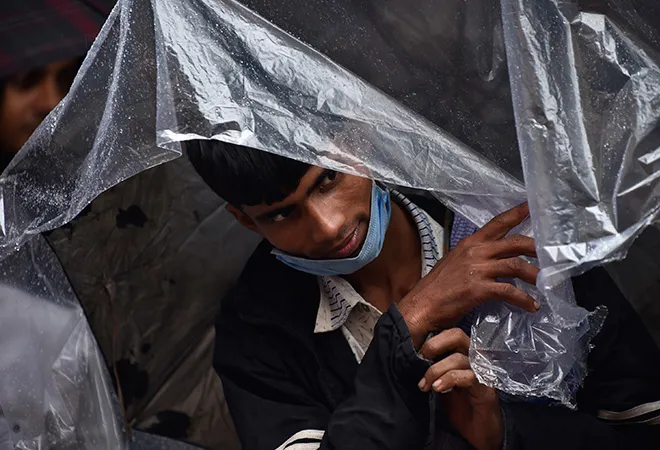-
CENTRES
Progammes & Centres
Location
If there are no alternative livelihood with newer employment opportunities, and given the sluggish economic growth pattern of the country — international labour migration will undoubtedly aggrandise.

The relationship between Nepal and India has stood the test of circumstances, time and again, through the existence of an open border. With the bilateral treaty of 1950 between the two countries, along with unplugged access to travel and work across brink, mass migration had come to be established as a core entity of negotiation and balance, without any formal record.
In this regard, a massive exodus of rural Nepalis, entangled in poverty, unemployment and more recently the civil war, migrating to India, had always been seen as a major trend. However, the recent Covid-19 situation prevailing all over the world has somewhat ‘reversed’ this scenario with migrant-returnees — placing them at the frontline of the crisis, unemployed, unpaid and vulnerable.
As a result of the geographical proximity and the economic opportunities, India is often one of the first choices for migration from Nepal. After the lockdown began in March, several hundreds of Nepalis walked miles to leave their host country and access the border points, which again were not open for numerous days.
A massive exodus of rural Nepalis, entangled in poverty, unemployment and more recently the civil war, migrating to India, had always been seen as a major trend.
Additionally, even after returning back home, around 98.7 per cent of the people found themselves at a loss of their basic household livelihood with nothing to bank on as a cushion. Approximately, 12 per cent of the returnees did not even have adequate food stock with the main source of income being crop production, livestock rearing and purchasing of the basic needs from the local market.
The small Himalayan landlocked nation has generally been depicted as one of the dependent countries of South Asia, trying to create its own niche in the process of South Asian nation building, despite its tremendous strategic significance as a ‘buffer state’. Nonetheless, it must be noted here that it is also one of the least developed countries in the world that has been able to move a step higher in the ladder with a ‘lower-middle income’ status in the recent past.
One of the primary reasons behind this upgrade has been the foreign currency that is flowing into the country through the thousands of migrant workers placed all over the world, especially the Gulf and the Southeast Asian countries. With an average of 66 per cent of the population living on subsistence agriculture in the rural areas, grappling with caste and gender disparities, labour migration has increased tremendously in the last few decades.
Indian states like Uttar Pradesh, Bihar, West Bengal and Assam remain the major hubs of such migration, for both the skilled as well the unskilled labourers, who try to move out of resource deficiency in their own country.
One of the first instances of Nepal supplying labour to India dates back to the recruitment of the Gorkha regiment of the British Army after the Anglo-Nepal War of 1814-15. Indian states like Uttar Pradesh, Bihar, West Bengal and Assam remain the major hubs of such migration, for both the skilled as well the unskilled labourers, who try to move out of resource deficiency in their own country.
In such a scenario, the contemporary picture presents difficulty in working out the actual number of Nepalis present in India. Several important factors like crossborder marriages, Indians historically rooted in Nepal and Nepalis who have been successful in gaining domiciled status in India, still cannot bring about the proper record for that matter, beyond 1 to 3 million Nepalese who are estimated to work in different parts of India.
Within this backdrop, the ever so augmenting working-age population of Nepal is supposedly to further increase by 20 million within 2025, which refers to an additional increment of work force by that period. In this regard, if there are no alternative livelihood in this pandemic with newer employment opportunities, given the sluggish economic growth pattern of the country, international labour migration will undoubtedly aggrandise.
The ever so augmenting working-age population of Nepal is supposedly to further increase by 20 million within 2025, which refers to an additional increment of work force by that period.
The Nepal-India migration corridor is still not a part of the present foreign employment policies and has been susceptible to the lack of data, inadequacy of social security coverage and also vulnerability of workers in the informal sector. There are both seasonal and long-term migrants to India-primarily the labour force, who are also consequently faced with problems like the transfer of remittances.
Facilitated by unregulated migration, there are several security threats that emanate from this zone and require proper collaboration and managerial skills on part of both the governments to combat such issues. One of the primary aspects includes the non-traditional security threats that have been lately making its presence felt in a more rigorous manner. Ranging from terrorism to human trafficking, drug trafficking and also the spread of infectious diseases like the COVID 19, the open border is also a bane that is beyond the generation of economy and employment.
First, even though it is mandatory for the Nepali migrants to depart only from the Nepal airport, requiring all the necessary documents of identity and migration along with employment in any foreign land, regular cases of using India as a transit point to head into a third country are being reported. This simultaneously questions the significance and relevance of the open border.
There are both seasonal and long-term migrants to India-primarily the labour force, who are also consequently faced with problems like the transfer of remittances.
In many situations, there are private recruitment agencies responsible for such issues which facilitate them from getting away from the legally bound system of migration and taking the responsibility of the people going at work or providing proper insurance facilities. In this recourse, fake passports and documents along with the widespread circulation of unaccounted foreign currency is also making its presence felt in the system, requiring proper scrutiny, thereby encouraging terrorist activities and other antisocial actions.
Secondly, there is rampant human trafficking that takes place across the border, primarily taking into account young women, girls and children who are sent to India in thousands every year. Many of them either end up in Indian brothels or are seen working as maids in the local neighbourhood, primarily against their wishes. The Human Trafficking and Transportation (Control) Act of 2007 and the Immoral Trafficking Prevention Act 1956 of India have been comprehensively ineffective in addressing such cases of concern.
Thirdly, the Indo-Nepal border has been diagnosed with the prevalence of widespread crossborder diseases like HIV/AIDS and malaria, caused by the inflow and outflow of the migration population. Mainly caused by the truckers and the traders, the returnee migrants from India have a prevalence rate of AIDS with 2.2 per cent.
There is rampant human trafficking that takes place across the border.
Though surveyed by the World Health Organisation and the national medical departments of both the countries, legal measures are still pending to work upon. Despite the prevalence of such issues, both the governments have failed to put a sincere check on the spread of diseases as a result of which the COVID-19 is moving beyond any sort of check. This situation runs the risk of explosion primarily during the festivities like Dassain and Navratri when a major chunk of the population try to return back home for the festivities, which have been of course curtailed this year.
The situation thus prevailing has to be improved in order to gain better connectivity opportunities between the two countries, who are trying to re-establish and renegotiate their relationship. Culturally and geographically contiguous, there can be several ways of addressing such loopholes of the open border and labour migration along with diseases and trafficking.
Only a systematic and orderly approach with proper sharing of information along with skill development can be of utility.
For instance, a comprehensive labour migration process, backed by strong legal aspects between India and Nepal can be established that will in turn protect the rights of the stakeholders. Only a systematic and orderly approach with proper sharing of information along with skill development can be of utility.
This is how the Nepal government can ensure safety for its citizens in any host country. In this process, the civil society actors can also be involved, helping to regenerate better response among the masses. This will develop human capital and also encourage betterment of diplomatic and bilateral ties between Nepal and its southern neighbor in such trying times.
This essay originally appeared in South Asia Weekly.
The views expressed above belong to the author(s). ORF research and analyses now available on Telegram! Click here to access our curated content — blogs, longforms and interviews.

Sohini Nayak was a Junior Fellow at Observer Research Foundation. Presently she is working on Nepal-India and Bhutan-India bilateral relations along with sub regionalism and ...
Read More +